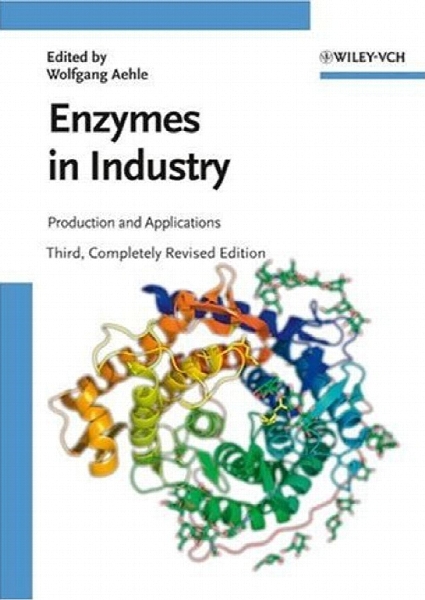Enzymes in industry : production and applications
- نوع فایل : کتاب
- زبان : انگلیسی
- مؤلف : Wolfgang Aehle
- ناشر : Weinheim : Wiley-VCH
- چاپ و سال / کشور: 2007
- شابک / ISBN : 9783527316892
Description
Preface to the Third Edition. List of Contributors. Abbreviations. 1 Introduction. 1 History. 1.2 Enzyme Nomenclature. 1.2.1 General Principles of Nomenclature. 1.2.2 Classification and Numbering of Enzymes. 1.3 Structure of Enzymes. 1.3.1 Primary Structure. 1.3.2 Three-Dimensional Structure. 1.3.3 Quaternary Structure, Folding, and Domains. 1.3.4 The Ribozyme. 1.4 Enzymes and Molecular Biology. 1.4.1 Biosynthesis of Enzymes. 1.4.2 Enzymes and DNA. 2 Catalytic Activity of Enzymes. 2.1 Factors Governing Catalytic Activity. 2.1.1 Temperature. 2.1.2 Value of pH. 2.1.3 Activation. 2.1.4 Inhibition. 2.1.5 Allostery. 2.1.6 Biogenic Regulation of Activity. 2.2 Enzyme Assays. 2.2.1 Reaction Rate as a Measure of Catalytic Activity. 2.2.2 Definition of Units. 2.2.3 Absorption Photometry. 2.2.4 Fluorometry. 2.2.5 Luminometry. 2.2.6 Radiometry. 2.2.7 Potentiometry. 2.2.8 Conductometry. 2.2.9 Calorimetry. 2.2.10 Polarimetry. 2.2.11 Manometry. 2.2.12 Viscosimetry. 2.2.13 Turbidimetry. 2.2.14 Immobilized Enzymes. 2.2.15 Electrophoresis. 2.3 Quality Evaluation of Enzyme Preparations. 2.3.1 Quality Criteria. 2.3.2 Specific Activity. 2.3.3 Protein Determination. 2.3.4 Contaminating Activities. 2.3.5 Electrophoretic Purity. 2.3.6 High-Performance Liquid Chromatography. 2.3.7 Performance Test. 2.3.8 Amino Acid Analysis and Protein Sequence Analysis. 2.3.9 Stability. 2.3.10 Formulation of Enzyme Preparations. 3 General Production Methods. 3.1 Microbial Production. 3.1.1 Organism and Enzyme Synthesis. 3.1.2 Strain Improvement. 3.1.3 Physiological Optimization. 3.1.4 The Fermentor and its Limitations. 3.1.5 Process Design. 3.1.6 Modeling and Optimization. 3.1.7 Instrumentation and Control. 3.2 Isolation and Purification. 3.2.1 Preparation of Biological Starting Materials. 3.2.2. Separation of Solid Matter. 3.2.3 Concentration. 3.2.4 Purification. 3.2.5 Product Formulation. 3.2.6 Waste Disposal. 3.3 Immobilization. 3.3.1 Definitions. 3.3.2 History. 3.3.3 Methods. 3.3.4 Characterization. 3.3.5 Application. 4 Discovery and Development of Enzymes. 4.1 Enzyme Screening. 4.1.1 Overview. 4.1.2 Natural Isolate Screening. 4.1.3 Molecular Screening. 4.1.4 Environmental Gene Screening. 4.1.5 Genomic Screening. 4.1.6 Proteomic Screening. 4.2 Protein Engineering. 4.2.1 Introduction. 4.2.2 Application of Protein Engineering in Academia and Industry. 4.2.3 Outlook. 5 Industrial Enzymes. 5.1 Enzymes in Food Applications. 5.1.1 Enzymes in Baking. 5.1.2 Enzymes in Fruit Juice Production and Fruit Processing. 5.1.3 Enzymes in Brewing. 5.1.4 Enzymes in Dairy Applications. 5.1.5 Other Food Applications. 5.2 Enzymes in Nonfood Applications. 5.2.1 Enzymes in Household Detergents. 5.2.2 Enzymes in Automatic Dishwashing. 5.2.3 Enzymes in Grain Wet-Milling. 5.2.4 Enzymes in Animal Feeds. 5.2.5 Enzymes in Textile Production. 5.2.6 Enzymes in Pulp and Paper Processing. 5.3 Development of New Industrial Enzyme Applications. 5.3.1 Introduction. 5.3.2 Enzymes in Cosmetics. 5.3.3 Enzymes for Preservation. 5.3.4 Enzymes in Hard-Surface Cleaning. 5.3.5 Enzymes Generating a pH Shift. 5.3.6 Enzymes in Cork Treatment. 5.3.7 Enzymes in Oil-Field Applications. 5.3.8 Enzymes in Wastewater Treatment. 5.3.9 Enzymes for Polymerisation: Wood Fiberboard Production. 5.3.10 Enzymes in Composting. 5.3.11 Application of Bacteriorhodopsin in Security Printing and Data Storage. 5.4 Overview of Industrial Enzyme Applications. 6 Nonindustrial Enzyme Usage. 6.1 Enzymes in Organic Synthesis. 6.1.1 Introduction. 6.1.2 Examples of Enzymatic Conversions. 6.1.3 Enzyme-Analogous Catalysts. 6.1.4 Commercial Applications. 6.1.5 Outlook. 6.2 Therapeutic Enzymes. 6.2.1 Requirements for the Use of Enzymes in Therapy. 6.2.2 Coping with Peculiar Protein Properties. 6.2.3 Sources of Enzymes and Production Systems. 6.2.4 Overview of Therapeutic Enzymes. 6.3 Analytical Applications of Enzymes. 6.3.1 Determination of Substrate Concentration. 6.3.2 Determination of Enzyme Activity. 6.3.3 Immunoassays. 6.3.4 Enzyme Dipsticks and Enzyme Sensors. 6.4 Enzymes for Food Analysis. 6.4.1 Carbohydrates. 6.4.2 Organic Acids. 6.4.3 Alcohols. 6.4.4 Other Food Ingredients. 6.5 Enzymes in Genetic Engineering. 6.5.1 Restriction Endonucleases and Methylases. 6.5.2 DNA Polymerases. 6.5.3 RNA Polymerases. 6.5.4 DNA Nucleases. 6.5.4.1 DNase I. 6.5.5 RNA Nucleases. 6.5.6 Modifying Enzymes. 7 Enzyme Safety and Regulatory Considerations. 7.1 Safe Handling of Enzymes. 7.1.1 Possible Health Effects. 7.1.2 Control Technology. 7.2 Product Regulatory Considerations. 7.2.1 Food-Use Enzymes. 7.2.2 Feed-Use Enzymes. 7.2.3 Industrial-Use Enzymes. References. Index.
Enzymes in Industry: Production and Applications, Third Edition bridges the gap between the industrial enzyme user and the enzyme specialist. An excellent introduction to enzymology at a basic level, the book concentrates on industrial enzyme production and the practical use of enzymes in industry.


